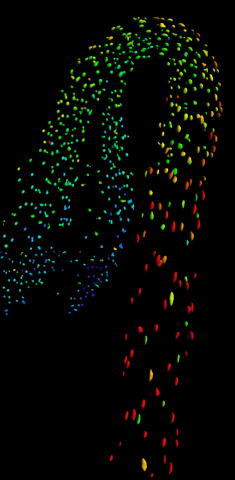Tang B., Lu, J., Leontovyčová, H., Hoffmann, G., Rowe, J.H., Fouquay O’Donnell, S, Grangé-Guermente, M., Larsen, B., Wimalasekera, R., Carella, P., Incarbone, M., Kalachova, T., Jones, A.M. (2025) SALICYLIC ACID SENSOR1 reveals the propagation of an SA hormone surge during pathogen advance. Science accepted.
Kiradjiev, K.B., Griffiths, J., Jones, A.M.*, Band, L.R.* (2025) A balance of metabolism and diffusion articulates a gibberellin hormone gradient in the Arabidopsis root. PNAS revised. DOI: 10.1101/2025.03.24.643304
Dao, T. Q., Drapek, C., Jones, A.M., Leiboff, S. (2025) Comparing hormone dynamics in cereal crops via transient expression of hormone sensors. Plant and Cell Physiology. DOI: 10.1093/pcp/pcaf080
Kubalová, M., Griffiths, J., Müller, K., Jones, A.M., Fendrych, M. (2025) Gibberellin-deactivating GA2OX enzymes act as a hub for auxin-gibberellin crosstalk in Arabidopsis thaliana root growth regulation. PNAS. DOI: 10.1073/pnas.2425574122.
Rowe, J.H., Josse, M., Tang, B., Jones, A.M. (2025) Quantifying Plant Biology with Fluorescent Biosensors. Annual Review of Plant Biology. DOI: 10.1146/annurev-arplant-061824-090615
Zhang, Y., Anfang, M., Rowe, J.H., Rizza, A., Bar, H., Charrier, L., Geisler, M., Jones, A.M., Shani, E. (2025) ABA importers ABCG17 and ABCG18 redundantly regulate seed size in Arabidopsis. Plant Journal. DOI: 10.1111/tpj.70096
Van Praet, S., Rizza, R., Tang, B., Xie, C., Jones, A.M., Inzé, D., Vanholme, B., Depuydt, S. (2025) Coumarin Promotes Hypocotyl Elongation in Light-grown Arabidopsis thaliana Seedlings by Enhancing Brassinosteroid Signalling in an Auxin-Dependent Manner. Journal of Plant Growth Regulation. DOI: 10.1007/s00344-024-11617-z
Walia A.†, Carter R.†, Wightman R., Meyerowitz E.M., Jönsson H.*, Jones A.M.* (2024) Differential growth is an emergent property of mechanochemical feedback mechanisms in curved plant organs. Developmental Cell. DOI: 10.1016/j.devcel.2024.09.021
Griffiths J., Rizza A., Tang B., Feng L., Frommer W.B., Jones A.M. (2024) GIBBERELLIN PERCEPTION SENSOR 2 reveals genesis and role of cellular GA dynamics in light-regulated hypocotyl growth. Plant Cell. DOI: 10.1093/plcell/koae198
Drapek C., Rizza A., Mohd-Radzman N., Schiessl K., Dos Santos Barbosa F., Wen J., Oldroyd G.E.D.*, Jones A.M.* (2024) Gibberellin dynamics governing nodulation revealed using GIBBERELLIN PERCEPTION SENSOR 2 in Medicago truncatula lateral organs. Plant Cell. DOI: 10.1093/plcell/koae201
- Highlighted by: Jhu and Irving (2024) Seeing hormones in action: High-resolution gibberellin dynamics in nodules. The Plant Cell. DOI: 10.1093/plcell/koae216
- Highlighted by: Hurst and Gifford (2024) In preprints: hormonal stepping stones to diverging root organogenesis. Development. DOI: 10.1242/dev.202636
Lorrai, R., Erguvan, Ö., Raggi, S., Jonsson, K., Široká4, J, Tarkowská, D., Novák, O, Jones, A.M., Verger, S., Robert, S., Ferrari, S. (2024) Cell wall integrity modulates a PHYTOCHROME-INTERACTING FACTOR 4 (PIF4) – HOOKLESS1 (HLS1) signalling module controlling apical hook formation in Arabidopsis. Plant Physiology. DOI: 10.1093/plphys/kiae370.
Rosa-Diaz I, Rowe JH, Cayuela-Lopez A, Arbona V, Diaz I, Jones AM (2024) Spider mite herbivory induces an abscisic acid-driven stomatal defense. Plant Physiology. DOI: 10.1093/plphys/kiae215
- Highlighted by: Gonzáles-Fuente (2024) Hold the door! Stomatal defense also protects against mites. Plant Physiology. DOI: 10.1093/plphys/kiae212
Larsen, B., Hofmann, R., Camacho, I.S., Clarke, R.W., Lagarias, J.C., Jones, A.R., Jones A.M. (2023) Highlighter is an optogenetic actuator for light-mediated, high resolution gene expression control in plants. PLOS Biology. DOI: 10.1371/journal.pbio.3002303
Rowe, J., Grangé-Guermente, M., Exposito-Rodriguez, M., Wimalasekera, R., Lenz, M., Shetty, K., Cutler, S.R., Jones, A.M. (2023) Next-generation ABACUS biosensors reveal cellular ABA dynamics driving root growth at low aerial humidity. Nature Plants. DOI: 10.1038/s41477-023-01447-4.
- Nature Plant Research Briefing: Visualising abscisic acid dynamics at low humidity in planta using ABACUS2. DOI: 0.1038/s41477-023-01469-y
Shi, B., Felipo-Benavent, A., Cerutti, G., Galvan-Ampudia, C., Jilli, L., Brunoud, G., Mutterer, J., Sakvarelidze-Achard, L., Davière, J-M., Navarro-Galiano, A., Walia, A., Lazary, S., Legrand, J., Weinstein, R., Jones, A., Prat, S., Achard, P.†, Vernoux, T.† (2024) A quantitative gibberellin signalling biosensor reveals a role for gibberellins in internode specification at the shoot apical meristem. Nature Comms. DOI: 10.1038/s41467-024-48116-4
Kubalová, M., Müller, K.,Dobrev, P.I., Rizza, A., Jones, A.M., Fendrych, M.† (2024) Auxin coreceptor IAA17/AXR3 controls cell elongation in Arabidopsis thaliana root by modulation of auxin and gibberellin perception. New Phytologist. DOI: 10.1111/nph.19557
Albuquerque-Martins, R., Szakonyi, D., Rowe, J., *Jones, A.M. and *Duque P. (2022), ABA signaling prevents phosphodegradation of the Arabidopsis SR45 splicing factor to negatively autoregulate inhibition of early seedling development. Plant Communications. DOI: 10.3390/life13061386
Mehra, P., Pandey, B.K., Melebari, D., Banda, J., Leftley, N., Couveur, V., Rowe, J., Anfang, M., De Gernier, H., Morris, E., Sturrock, C.J., Mooney, S.J., Swarup, R., Faulkner, C., Beeckman, T., Bhalerao, R.P., Shani, E., Jones, A.M., Dodd, I.C., Sharp, R.E., Sadanandom, A., Draye, X., Bennett, M. J. (2022) Hydraulic flux responsive hormone redistribution determines root branching. Science. 378(6621):762-768. DOI: 10.1126/science.add3771
Pablo Albertos, Tanja Wlk, Jayne Griffiths, Maria J Pimenta Lange, Simon J Unterholzner, Wilfried Rozhon, Theo Lange, Alexander M Jones, Brigitte Poppenberger (2022) Brassinosteroid-regulated bHLH transcription factor CESTA induces the gibberellin 2-oxidase GA2ox7, Plant Physiology, Volume 188, Issue 4, April 2022, Pages 2012–2025. DOI: 10.1093/plphys/kiac008
Robinson, S., Whitewoods, C., Otero, S., Jones, A.M. (2022) Vegetative Development Chapter. Plant Physiology and Development, 7th Edition.
James H Rowe, Annalisa Rizza, Alexander M Jones (2022) Quantifying Phytohormones in Vivo with FRET Biosensors and the FRETENATOR Analysis Toolset. In: Duque, P., Szakonyi, D. (eds) Environmental Responses in Plants. Methods in Molecular Biology, vol 2494. Humana, New York, NY. DOI: 10.1007/978-1-0716-2297-1_17
Martin Balcerowicz, Kartika N. Shetty, Alexander M. Jones (2021) Fluorescent biosensors illuminating plant hormone research, Plant Physiology, Volume 187, Issue 2, October 2021, Pages 590–602. DOI: 10.1093/plphys/kiab278
Cesar L Cuevas-Velazquez, Tamara Vellosillo, Karina Guadalupe, Hermann Broder Schmidt, Feng Yu, David Moses, Jennifer AN Brophy, Dante Cosio-Acosta, Alakananda Das, Lingxin Wang, Alexander M Jones, Alejandra A Covarrubias, Shahar Sukenik, José R Dinneny (2021) Intrinsically disordered protein biosensor tracks the physical-chemical effects of osmotic stress on cells. Nat Commun 12, 5438. DOI: 10.1038/s41467-021-25736-8
Rizza A, Tang B, Stanley CE, Grossmann G, Owen MR, Band LR, Jones AM (2021) Differential biosynthesis and cellular permeability explain longitudinal gibberellin gradients in growing roots. PNAS. DOI: 10.1073/pnas.1921960118
Jayne Griffiths, Roberto Hofmann, Alexander M Jones (2021) Signals| Gibberellin Signaling in Plants. Elsevier. DOI: 0.1016/B978-0-12-819460-7.00322-4
James H Rowe, Alexander M Jones (2021) Focus on biosensors: Looking through the lens of quantitative biology. Quantitative Plant Biology. DOI: 10.1017%2Fqpb.2021.10
Martin Balcerowicz, Kartika N Shetty, Alexander M Jones (2021) O auxin, where art thou? Nat Plants. DOI: 10.1038/s41477-021-00921-1
Annalisa Rizza, Alexander M Jones (2019) The makings of a gradient: spatiotemporal distribution of gibberellins in plant development. Current Opinion in Plant Biology. DOI: 10.1016/j.pbi.2018.08.001
Annalisa Rizza, Ankit Walia, Bijun Tang, Alexander M Jones (2019) Visualizing Cellular Gibberellin Levels Using the nlsGPS1 Förster Resonance Energy Transfer (FRET) Biosensor. J. Vis. Exp. (143). DOI: 10.3791/58739
Ankit Walia, Rainer Waadt, Alexander Jones (2018) Genetically encoded biosensors in plants: pathways to discovery. Annual Reviews. DOI: 10.1146/annurev-arplant-042817-040104
Rizza A, Walia A, Lanquar V, Frommer WB, Jones AM. In vivo gibberellin gradients visualized in rapidly elongating tissues. Nature Plants 2017. DOI: 10.1038/s41477-017-0021-9
- Recommended by F1000
- Highlighted in News & Views article: Azoulay-Shemer, T, Hsu P-K, Schroeder JI (2017) Nature Plants 3, 765–766. DOI: 10.1038/s41477-017-0025-5
Alexander M Jones (2015) A new look at stress: abscisic acid patterns and dynamics at high-resolution. New Phytologist. DOI: 10.1111/nph.13552
- Winner of the Tansley Medal. Lennon S. and Dolan L. (2016) New Phytologist. DOI: 10.1111/nph.13891
Alexander M Jones, Yuanhu Xuan, Meng Xu, Rui-Sheng Wang et al. (2014) Border control – a membrane-linked interactome of Arabidopsis. Science. DOI: 10.1126/science.1251358
Alexander M Jones*, Danielson JA, ManojKumar S, Lanquar V, Grossman G, Frommer WB* (2014) Abscisic acid dynamics in roots detected with genetically encoded FRET biosensors. eLife. DOI: 10.7554/elife.01741
- Highlighted in eLife Insight article: Choi W-G, Gilroy S. eLife. 2014; 3: e02763.
- Highlighted in The Scientist Modus Operandi article: Williams R. Stressing and FRETing. August 1st 2014.
Alexander M Jones†, Grossman G†, Frommer WB (2013) In vivo biochemistry: Applications for small molecule biosensors in plant biology. Current Opinion in Plant Biology. DOI: 10.1016%2Fj.pbi.2013.02.010 †equal contribution
Okumoto S†, Alexander M Jones†, Frommer WB. Quantitative imaging with fluorescent biosensors. Annu Rev Plant Biol. 2012. DOI: 10.1146/annurev-arplant-042110-103745 †equal contribution
Alexander Jones, Wildermuth MC (2011) The phytopathogen Pseudomonas syringae pv tomato DC3000 has three high-affinity iron-scavenging systems functional under iron limitation conditions but dispensable for pathogenesis. J Bacteriol. DOI: 10.1128/jb.00069-10
Gilkerson J., Hu J., Brown J., Jones A., Sun T.P., Callis J. (2009) Isolation and characterization of cul1-7, a recessive allele of CULLIN1 that disrupts SCF function at the C terminus of CUL1 in Arabidopsis thaliana. Genetics. DOI: 10.1534/genetics.108.097675
Alexander M Jones, Lindow SE, Wildermuth MC (2007) Salicylic acid, yersiniabactin, and pyoverdin production by the model phytopathogen Pseudomonas syringae pv tomato DC3000: synthesis, regulation, and impact on tomato and Arabidopsis host plants. J Bacteriol. DOI: 10.1128/jb.00827-07 *co-corresponding author, † equal contribution
 After undergraduate research on the phytohormone auxin (with Judy Callis, UC Davis), my PhD was focused on the role of the immune hormone salicylic acid (SA) in both root development and in crosstalk between host plants and a bacterial pathogen that synthesizes SA (with Mary Wildermuth, UC Berkeley). In one project, I developed a promoter-reporter line that is highly sensitive to SA and found evidence of a transient accumulation of SA in the Arabidopsis root tip. In conjunction with my investigations of the mechanism of root growth inhibition by SA, I hypothesized that root tip localized SA carries out an unknown function in root development. In a second project centred on the question of how the pathogen acquires iron from plants, I found that the bacterium has three high-affinity iron acquisition systems. Because a mutant lacking all three remained fully pathogenic, I hypothesized that, unlike many mammalian pathosystems, the pathogen’s environment is relatively iron replete. In both projects, progress on my new hypotheses stalled because I was unable directly quantify the levels of SA or iron with the necessary spatiotemporal resolution using available technologies.
After undergraduate research on the phytohormone auxin (with Judy Callis, UC Davis), my PhD was focused on the role of the immune hormone salicylic acid (SA) in both root development and in crosstalk between host plants and a bacterial pathogen that synthesizes SA (with Mary Wildermuth, UC Berkeley). In one project, I developed a promoter-reporter line that is highly sensitive to SA and found evidence of a transient accumulation of SA in the Arabidopsis root tip. In conjunction with my investigations of the mechanism of root growth inhibition by SA, I hypothesized that root tip localized SA carries out an unknown function in root development. In a second project centred on the question of how the pathogen acquires iron from plants, I found that the bacterium has three high-affinity iron acquisition systems. Because a mutant lacking all three remained fully pathogenic, I hypothesized that, unlike many mammalian pathosystems, the pathogen’s environment is relatively iron replete. In both projects, progress on my new hypotheses stalled because I was unable directly quantify the levels of SA or iron with the necessary spatiotemporal resolution using available technologies.
